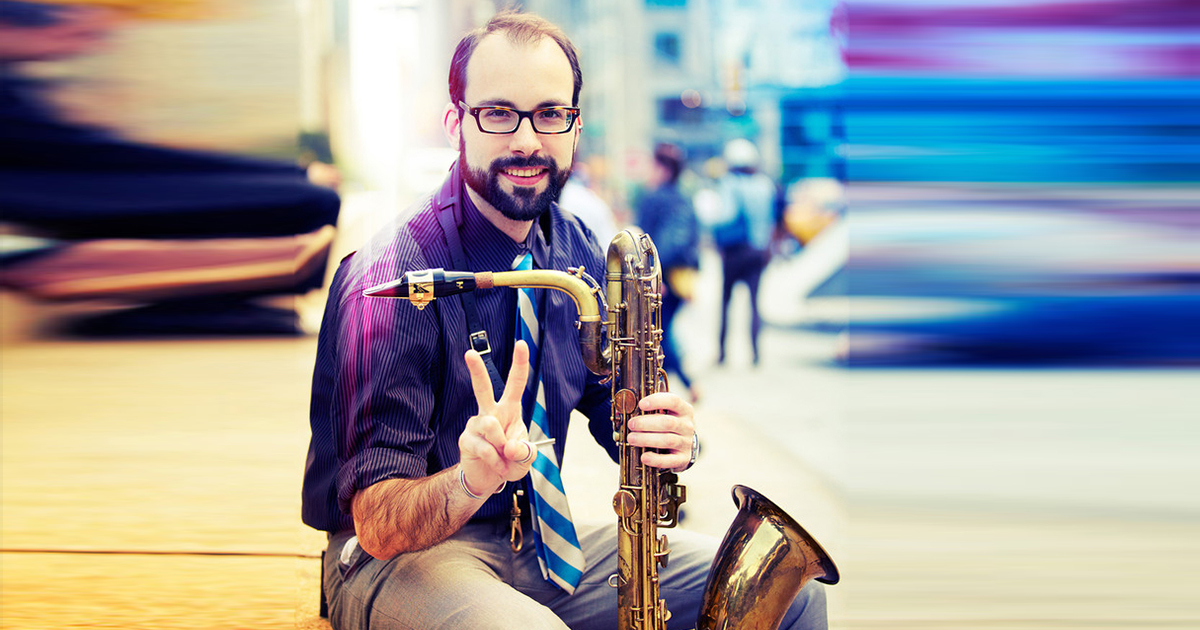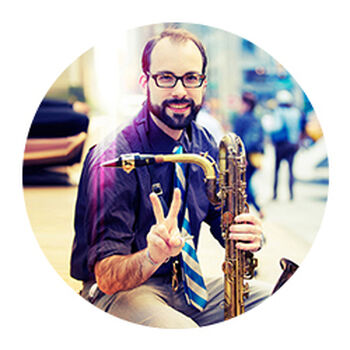An Essential Guide to The Baritone Saxophone in Jazz
by Andrew Hadro
Date Posted: June 25, 2020

Photo by James Korn
The baritone saxophone is not often considered a solo instrument in Jazz, but for those willing to do some digging there is a whole world of great soloists on this large horn. I have compiled a list of 5 albums that will provide a great starting point for anyone looking to get into jazz baritone saxophone.
The hardest part of developing this list is whittling it down and deciding what precious few albums to include. For this list I first chose 5 albums that I think have been most influential for the baritone saxophone in jazz. For further listening I have included “Further Listening” albums that are well worth checking out, and are perhaps more obscure, or maybe more artistically valuable. Of course, there are many more baritone saxophonists to enjoy, including a whole host of modern-day baritone saxophonists all creating great music. I would encourage you to check out http://jazzbarisax.com to see a more complete list of the baritone saxophonists in jazz.
Andrew Hadro is a New York City based baritone saxophonist as well as product specialist for Vandoren and curator of JazzBariSax.com
1. Gerry Mulligan – “Gerry Mulligan Quarter, Volume 1”
Gerry Mulligan is the first introduction to the baritone saxophone as a soloistic instrument for many people. This is due to his general popularity as well as his amenable sound and approach to melodic playing. Mulligan was primarily a band leader and a soloist, escaping the fate that falls to most baritone saxophonists as that of a sideman or under-used part of a big band saxophone section. Mulligan had a long career and first came to prominence with his ‘piano-less’ quartet with Chet Baker. He and Chet both had somewhat of a playboy personality that no doubt helped feed their popularity. Mulligan can also be found on the Miles Davis album ‘Birth of the Cool’, both as a player and as an arranger. This no-doubt also helped send him to the forefront of baritone saxophone soloists.
For me, the Concert Jazz Band was the most interesting of Mulligan’s projects (See below). This could somewhat be due to the great writers he had working with him. Indeed, Bob Brookmeyer is behind a lot of the music here. I once read that when the Concert Jazz Band was out of work some of the musicians, including Brookmeyer and Mel Lewis got together on their own and began a large ensemble. This ensemble became the Thad Jones/Mel Lewis Orchestra and eventually the Vanguard Jazz Orchestra that still exists today.
Further Listening Albums: “Night Lights”, “What Is There To Say?”, “The Concert Jazz Band At the Village Vanguard”
2. Pepper Adams – “Encounter!”
Pepper Adams‘ playing is biting and intelligent. His sound is huge and aggressive, and he was part of many well-known and well-regarded recordings as a sideman in groups small and large. Most Junior Highschool baritone saxophonists know the opening line to the Charles Mingus song ‘Moanin’ But I’m not sure they all realize that it was Pepper that originally stated it and performed it. Adams can be found on many incredible recordings as a sideman. As a long-standing member of the Thad Jones/Mel Lewis Orchestra, with Charles Mingus, Donald Byrd, and even John Coltrane. He may not have achieved the mainstream popularity that Mulligan enjoyed but I think he has a greater influence in general on dedicated baritone saxophonists, through his sound, harmonic fluency, and approach to the horn.
From all accounts Pepper was an incredibly humble, witty and soft-spoken musician. Many of the greatest baritonists around today are very much in debt to the lineage he created.
Further Listening Albums: “10 to 4 at The 5 Spot”, “Blues & Roots” [Charles Mingus], “Ephemera”
3. Harry Carney – “Far East Suite” [Duke Ellington]
Harry Carney was Duke Ellington’s baritone saxophonist. The only one he ever really had. He joined Duke’s band at 17 and stayed for 47 years, ultimately dying 6 months after Duke himself. He was remarkably close to Duke, often driving him from gig to gig in Carney’s own car, whereas the rest of the band would be in a separate bus. Duke was at different points one of the most recognizable musicians in the world, and as such Carney had a lot of opportunities to shine. Carney was an able soloist, and there are plenty of recordings that include his solos. But he is far and away more revered for his sound and ensemble playing. It is simultaneously the biggest yet most beautiful sound the baritone can make. Whenever I hear Duke’s band, I often think of it as ‘Harry Carney, and the rest of the band’ as you can always prominently hear Carney’s beautiful sound adding incredible weight to the band.
Harry had many features with the Ellington band, and is even credited as writer for a few songs. His most well-known feature was ‘Sophisticated Lady’ A ballad that featured his lush tone. My personal favorite album to hear Carney’s sound is the “Far East Suite” The whole album is rich with his sound and in particular ‘Agra’ is a great feature for him. He did not record much as a leader, but there is an album he recorded featuring him with lush string arrangements. The improvising is not the most sophisticated, but his sound is worth the price of admission.
Further Listening Albums: “Harry Carney With Strings”, “The Duke’s Men”
4. Nick Brignola, Ronnie Cuber, Gary Smulyan – “Three Baritone Band Plays the Music of Gerry Mulligan”
Boiling down a list of your heroes is tough. So, I am going to go ahead and cheat here. I am going to include these three titans of the baritone saxophone in one entry and justify it because there is an album that features all three of them. The album features songs composed by or associated with Gerry Mulligan. Ironically, I would say all three of these guys fall more closely to the Pepper Adams school of baritone. The album is great and all three of them deserve to be checked out in full. Both Gary and Ronnie are still with us and if you get a chance to see them perform you should absolutely take it.
4A) Nick Brignola
Nick Brignola was a self-taught fiend on the baritone. His technical skill, speed, and use of altissimo are thrilling, as well as his command of bop language and interesting album concepts. He had a very strong, projecting sound, along with a mastery of jazz language and fluency over the whole horn. He was especially known for his ability to play extremely fast tempos.
Further Listening Albums: “What It Takes”, “Raincheck”, “The Flight of the Eagle”
4B) Ronnie Cuber
Ronnie is one of the greats, not just of the baritone but perhaps of the saxophone. He has made great recordings in a number of genres, straight ahead jazz, blues-centric popular recordings with George Benson, Latin Jazz, Fusion, and plenty of Hard-Bop. He has anchored the saxophone section of a number of great big bands but always turned heads when he stepped out front as a soloist. Ronnie is still active as a performer and has put out several albums in the last few years.
Further Listening Albums: “In A New York Minute”, “Cubism”, “Its Uptown” [George Benson]
4C) Gary Smulyan
Gary is a direct musical descendant of Pepper Adams, though he has developed a unique sound and style that can be easily differentiated. Gary is an incredible soloist, master of harmony, obscure songs, as well as a very long-standing member of the Vanguard Jazz Orchestra (since 1980!). Gary is still very active, performing, recording, and teaching. If you have an opportunity to see Gary in person I urge you to do so.
Further Listening Albums: “Hidden Treasures”, “Saxophone Mosaic”, “Blue Suite”
5. Serge Chaloff – “Blue Serge”
Serge Chaloff is another well-known historical baritone saxophonist. He had a more delicate approach to the baritone with a beautiful tone and very melodic approach. Though he pre-dates mulligan by a bit, people often compare his approach to Mulligan’s. Despite serious drug and alcohol problems he did have some success and notoriety. For this album’s solo work, but perhaps more so for his membership in Woody Herman’s ‘Herd’ big band. Serge was the baritone player on the original “Four Brother” Recording. He was one of the earliest people to step out and become a band leader and soloist solely on the baritone sax. Despite passing away at age 33 Serge made a lasting impact on music and specifically the baritone saxophone.
Further Listening Albums: “Boston Blow Up”

About the Author
Andrew Hadro is a professional musician, composer, and bandleader in Brooklyn, New York. Hadro’s primary instrument is baritone saxophone, though he also performs on bass clarinet, Bb clarinet, and flute, and is one of the only working musicians in New York City to play the bass saxophone.
Recently, Hadro has been presenting compositions by current living composers through his ongoing project "For Us, The Living," An effort to honor tradition through innovation. Hadro has performed and recorded two albums for this series, with the most recent released in April 2018.
After 15 years in NYC, Hadro can be heard through an expanding discography and frequent live performances. He has played with and led ensembles large and small, featuring historical and modern styles, as well as through-composed and fully improvised music.
Born abroad in Mexico to American parents, Hadro spent most of his childhood in the Chicago area before moving to New York City to study at the New School for Jazz. In addition to working as a performer, Andrew Hadro is a product specialist for Vandoren, advising fellow musicians on equipment including reeds and mouthpieces. As curator of JazzBariSax.com Hadro provides resources and news to baritone saxophonists all over the world. During summers Hadro serves as a director and faculty member for the Litchfield Jazz Camp in Connecticut.